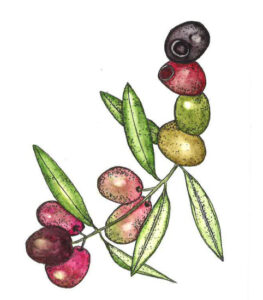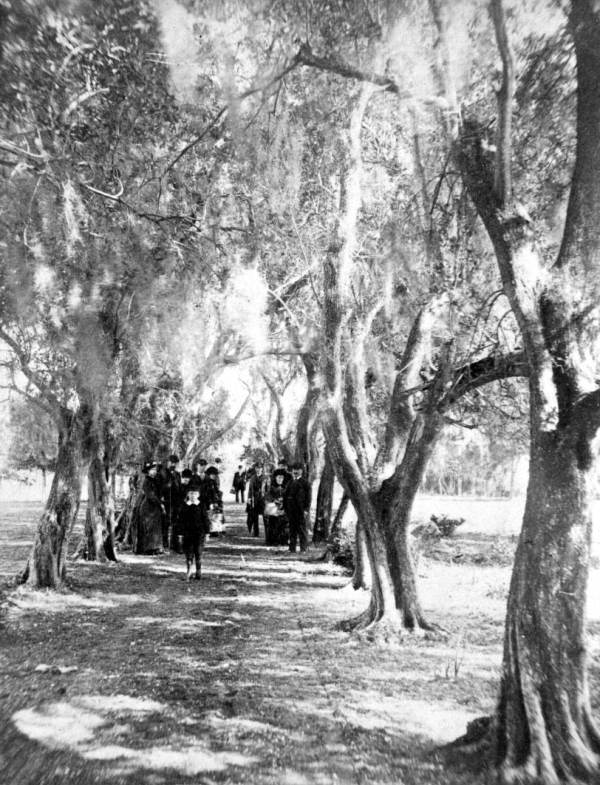Olive
Olea europaea

जैतून (jaitoon, Hindi), ઓલિવ (Ōliva, Gujarati), Saytuunka (Somali), matunda ya zaituni (Swahili), زیتون (zaytoon, Arabic),橄榄 (gǎn lǎn, Mandarin), aceituna (Spanish)
Olives have been cultivated in the eastern Mediterranean region for more than 6,000 years. Olive orchards were a significant part of ancient economy and cultures, including biblical traditions where olives and olive oil are important symbols representing prosperity, anointing, healing, and the love of God. The tree made its way to the Americas during European colonialism, and olive oil remains a common ingredient today in food and body care products. The olive tree has recently experienced a resurgence in popularity among small farms and gardeners in Florida due to its tolerance for heat and well-drained soil.

Genetic analysis of ancient olive trees suggests that they were first cultivated 8,000 – 6,000 years ago in the eastern Mediterranean region. Olives spread throughout the ancient world, and olive orchards played a significant role in ancient economies and societies for thousands of years. Olive trees eventually made their way to the Americas through European colonization, and the first olives were planted in California in 1769. Olive cultivation in Florida dates back to the early 1800s when the Florida Olive Company in Quincy, Florida became the largest olive oil producer in the United States. However, the company went bankrupt in the early 1900s due to a combination of factors, including insect infestations and the Great Depression. In the early 2000s, there was renewed interest in olive cultivation in Florida, particularly in the northern parts of the state. The University of Florida began conducting research to develop cultivars that were better adapted to the state’s climate and soil conditions. Today, there are small-scale olive groves throughout Florida. While commercial production remains limited, many small farms and gardeners plant olive trees as an ideal drought tolerant crop that does well in poor soil and hot weather.
Olives have been an important culinary, health, and symbolic food for thousands of years in several civilizations. Ancient Greeks competed in games to win a container, known as an amphora, of olive oil; the olive was sacred to the Greek goddess Athena and Roman Minerva. Olive branches served as a symbol of peace in the crown of the Olympic games.
In the Bible, olives are mentioned primarily for their oil, which was used for cooking, lighting lamps, and religious purposes. They are listed as one of the seven species of fruit abundant in the land of Israel and are compared to trust in God in the book of Psalms. In the New Testament, olives are mentioned in parables, such as the story of the wise and foolish virgins and the Good Samaritan, representing preparedness, compassion, and the love of God. Olive oil is used in anointing rituals today in much of the same way it has been used for thousands of years.
Olives have also become a staple food throughout the world. They are used in dishes such as salads, pastas, and pizzas. Olive oil, derived from the fruit, is used for cooking, as well as for medicinal and cosmetic purposes.

Green olives contain significant amounts of calcium, potassium, vitamin A, beta carotene and lutein.


Plant via cuttings or transplants in a sunny, well-drained location in March through May; harvest will be in November about 3 years after planting. Some varieties are better for pressing for oil and others for preserving. “Arbequina” is a popular self-pollinating variety in Florida gardens
To plan a Florida heritage garden, download the ‘Planning a Florida Heritage Garden (PDF).’

Santa Fe College Partnered with Multiple Organizations in a Collaborative Effort to Bring Awareness of the Heritage Plants In Florida.
BY CULTURAL HISTORY
BY GROWING SEASON
DROUGHT TOLERANT PLANTS
Commitment to Equal Access and Equal Opportunity
Santa Fe College is committed to an environment that embraces diversity, respects the rights of all individuals, is open and accessible, and is free of harassment and discrimination. For more information, visit sfcollege.edu/eaeo or contact equity.officer@sfcollege.edu.
SACSCOC Accreditation Statement
Santa Fe College is accredited by the Southern Association of Colleges and Schools Commission on Colleges (SACSCOC). For more information, visit sfcollege.edu/sacscoc.
